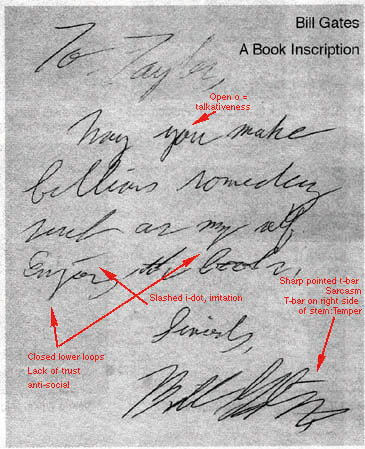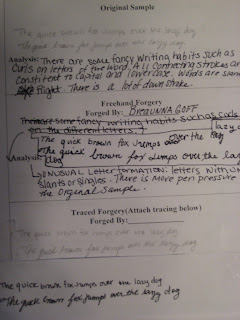This part of learning about Forensics tested everything that we have learned over the past few months. When we walked into the calssroom there were three rows. Each row had its own crime scene, my group and I were given an outdoor scene in which a decomposed body, three fingerprints, possible poison, a suicide letter, hair, fiber, two different footprints, and a syringe were found. Using these clues we had to determine a possible victim, and suspect from the line up that was presented on the board. When choosing the victims and suspects we had to be very careful because each suspect on the board was being used for all three crime scenes, this mean that the use of al of our evidence was extremely important.

 The first thing that we did as a group was to piece together the suicide letter, the letter read "Please forgive me! I love you all.", we then compared the letter to handwriting samples given by the suspects on the board, the handwriting matched that of Lucas Moore, man who had spent time in a psych. ward because of depression. We then compared fingerprints found at the scene to those of Lucas Moore and the others. Lucas Moore's fingerprint matched exhibit number three which was a plain arch, we then compared exhibit number eight an undeveloped fingerprint, the print was a ulnar loop, and it matched that of Sandra O'Conner a homless drug addict convicted of drug possession and breaking/entering. The third and final fingerprint was that of Jet Trong, it was also a double loop print, a mechanic who had been convicted of drug possession, breaking/entering, and domestic violence. The hair found at the scene appeared to be dog hair, and the fiber was determined to ahve been wool. After testing the possible poison it was determined to have been cocaine, the syringe that we found could have been used by the suspect or the vitim to ingest the cocaine. We then analyzed the footprints and detetermined that, based on the size of the prints, the one found on the victims body was that of a female, and that the other print belonged to a tall male. At the time the body was found we determined that the time of death would have been about two weeks before the body was discovered do to the maggots and the decomposition.
The first thing that we did as a group was to piece together the suicide letter, the letter read "Please forgive me! I love you all.", we then compared the letter to handwriting samples given by the suspects on the board, the handwriting matched that of Lucas Moore, man who had spent time in a psych. ward because of depression. We then compared fingerprints found at the scene to those of Lucas Moore and the others. Lucas Moore's fingerprint matched exhibit number three which was a plain arch, we then compared exhibit number eight an undeveloped fingerprint, the print was a ulnar loop, and it matched that of Sandra O'Conner a homless drug addict convicted of drug possession and breaking/entering. The third and final fingerprint was that of Jet Trong, it was also a double loop print, a mechanic who had been convicted of drug possession, breaking/entering, and domestic violence. The hair found at the scene appeared to be dog hair, and the fiber was determined to ahve been wool. After testing the possible poison it was determined to have been cocaine, the syringe that we found could have been used by the suspect or the vitim to ingest the cocaine. We then analyzed the footprints and detetermined that, based on the size of the prints, the one found on the victims body was that of a female, and that the other print belonged to a tall male. At the time the body was found we determined that the time of death would have been about two weeks before the body was discovered do to the maggots and the decomposition.  After analyzing all the evidence we each came up with a thought for how the victim had died and who had been involved in the possilbe murder. My thought was that the victim was Sandra O'Conner. Her fingerprints were found at the scene and the shoe found on the body looked like that of a female. Since she was convicted of drug posession it seemed plausible that she would have access to such a drug, she was also homeless so it made since that she would be found in the woods. I hypothesized that the drugs had been bought from Jet Trong, he also had been convicted of drug possession, since his fingerprints were also found at the scene this also seemed possible. Since Lucas Moore's fingerprints were also found at the scene along with the note that matched his handwriting. I took into consideration that Moore was a depressed man, so my thought was that he was taking the drugs as a way to feel better becasue of his deppression. The dog hair was foud because Sandra had a dog at the scene, he might have run away in search for food. Overall my thought is that sandra O'Conner bought drugs from Jet Trong. Somehow Sandra and Lucas knew each other, so they went into the woods to do drugs together. Things got out of hand and Sandra overdosed on the cocaine, and in an attempt to cover up the death and the fact that he had been doing drugs Lucas wrote a suicide note in the hopes that nobody would think he had murdered her.
After analyzing all the evidence we each came up with a thought for how the victim had died and who had been involved in the possilbe murder. My thought was that the victim was Sandra O'Conner. Her fingerprints were found at the scene and the shoe found on the body looked like that of a female. Since she was convicted of drug posession it seemed plausible that she would have access to such a drug, she was also homeless so it made since that she would be found in the woods. I hypothesized that the drugs had been bought from Jet Trong, he also had been convicted of drug possession, since his fingerprints were also found at the scene this also seemed possible. Since Lucas Moore's fingerprints were also found at the scene along with the note that matched his handwriting. I took into consideration that Moore was a depressed man, so my thought was that he was taking the drugs as a way to feel better becasue of his deppression. The dog hair was foud because Sandra had a dog at the scene, he might have run away in search for food. Overall my thought is that sandra O'Conner bought drugs from Jet Trong. Somehow Sandra and Lucas knew each other, so they went into the woods to do drugs together. Things got out of hand and Sandra overdosed on the cocaine, and in an attempt to cover up the death and the fact that he had been doing drugs Lucas wrote a suicide note in the hopes that nobody would think he had murdered her. 














